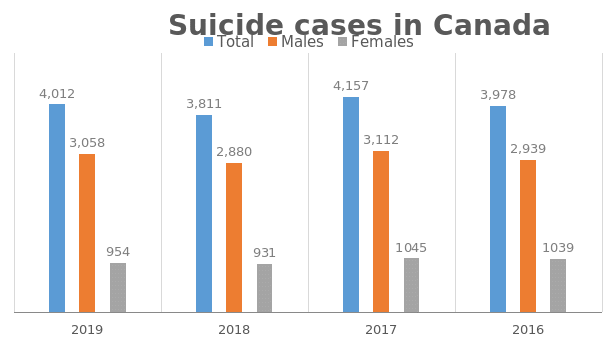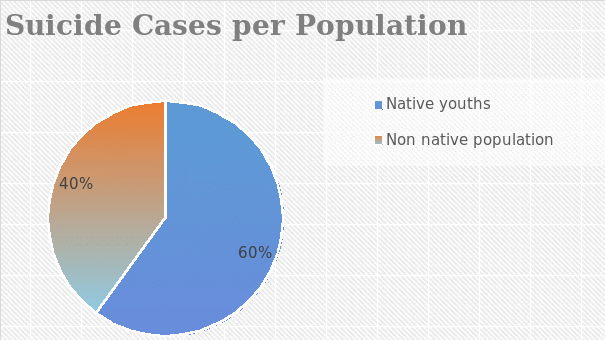Introduction
- Suicide is one of the health crises that Canada is facing in the recent years.
- It is high among the indigenous youths in Canada.
- Indigenous suicide was rare in the past (Chandler & Lalonde, 2008a).
- The native people connected with their natural beliefs, culture, and language which forbidden suicide.
- The acts of suicide started increasing after the coming of the Europeans.
- Creation of schools denied the indigenous people their cultural practices.
Even though Canada is considered one of the world’s developed countries, suicide cases are rising, especially among the indigenous groups. Initially, indigenous people had their set rules and culture which discouraged suicide, and they respected their culture; hence the issues of suicide were minimal. However, Europeans’ arrival triggered the increase of the suicide cases as they imposed a school system and forced the natives to abandon their culture. Colonialism led to the rise in suicide cases as the youths were killing themselves in protest of the foreign culture.
Definition of Terms
- Suicide – the act of taking one’s own life.
- Suicide attempt – unsuccessful attempt to kill oneself.
- Cultural continuity – the transfer of cultural knowledge from one generation to another.
- Indigenous people – the native people who have known place of origin except where they are located.
Suicide is the act of killing oneself due to personal reasons. It can be done by inflicting body pain or intentionally getting into an activity that will terminate life within a short time. If the person fails in ending their own life, it is known as a suicide attempt. People who attempt suicide are those who have already decided that they never want to live anymore and have lost hope for the future. However, the cultural community is the passing of traditional beliefs and practices from one culture to another. Although most cultures are eroded due to interaction with other organizations, some are unique to a specific community. Finally, indigenous people are individuals who have retained their cultural practices and beliefs.
Causes of Suicide among Indigenous Youths
- State of mental health
- Low self esteem
- Depression
- Rapid culture changes
- Isolation or lack of support from the guardians
- Discrimination by other people
- Forced adoption
Indigenous youths kill themselves for various reasons. According to Barker et al. (2017), they live in abject poverty, which may cause them to perform suicide. As a result of low living standards, the majority experience mental health issues that may make them take their own lives. Research conducted by Chandler and Lalonde (1998) reveals that mental health is the leading cause of suicide cases in Canada. Additionally, youths who have low self-esteem can kill themselves because they feel unaccepted and unworthy in society. Depression is another factor that causes suicide among indigenous children. Most native youths are unemployed and uneducated; therefore, they find it difficult to afford the high standards of living in the country; thus, they become depressed and see suicide as the only remedy to their problems. Isolation, discrimination, and forced adoption also led to suicide.
Cultural Continuity
- Indigenous people in Canada experience high levels of cultural continuity.
- The natives are the minority groups.
- The native culture has been eroded overtime.
- Cultural interaction has created confusion in the cultural continuity of the indigenous youths.
- Some cultural practices conflicts with the national laws (Chandler & Lalonde, 2008a).
The aboriginal community is a minority group in Canada. Although they have abandoned some of their traditional practices, they value their culture and still adhere to most old traditions. However, due to interaction between the community and the non-indigenous groups, the native youths currently have mental confusion. They strive to balance traditional methods and modern culture. Although the traditional culture is protected by law in Canada, some practices conflict with the national government’s rules, forcing the traditional communities to abandon them.
Relating Cultural Continuity With Suicide
- Government initiatives have forced that aboriginal community to commit suicide.
- There is too much pressure on the young indigenous people from the society to adopt the new culture.
- Cultural erosion has also made the young indigenous people to commit suicide.
- Loss of indigenous knowledge of how to preserve life has also contributed to suicide cases (Chandler & Lalonde, 2008b).
- Forcing civilization to the native youths has also led to increased cases of suicide among the native community.
The Canadian government has initiated some activities meant to raise people’s living standards across the country. However, the initiatives may be against the norms and of the native community. This, therefore, makes the community members resist the system and commit suicide. Moreover, there is too much pressure on the youths who are expected to embrace civilization while at the same time practicing indigenous knowledge. Therefore, life pressures become too much to handle, and the only solution to the situation is to end life. Moreover, the natives had ways of encouraging or teaching the young to preserve life. However, cultural erosion that has been witnessed over the past year has led to cultural adoption of new ways; thus, the community has lost teaching the young people the importance of living.
Preventing Suicide Cases among Indigenous Community
- Raising awareness
- Continuing with school based suicide programs for students who travel to new places to continue with their education (Chandler & Lalonde, 1998).
- Befriending indigenous youths
- Accepting the indigenous groups in the society
- Helping the indigenous community to preserve their culture
- Using the cultural approach as a way of eradicating suicide issues (Barker et al., 2017)
Indigenous people are part of the community; hence they should be accepted. Although they have a unique culture, accepting them will make them feel part of the society, therefore, integrating their culture with the societal practices. Moreover, befriending the indigenous youths will help them eliminate suicidal thoughts that they may be having (Hicks, 2018). The human being is a social animal that needs friends for companion. Additionally, native youths who transfer to new areas to acquire education may experience culture shock, forcing them to commit suicide. Therefore, promoting educational-based suicide programs will encourage the indigenous students to accept their new community and eliminate suicide cases.
Statistics of Suicide Deaths


Suicide is the second leading cause of death among youths in the overall Canadian population. Male people are more likely to commit suicide than their female counterparts. According to the center for suicide prevention, suicide cases have been increasing even though numerous attempts to reduce the spread (“Suicide stats for Canada”, n.d.).
Conclusion
- High rates of suicide cases is witnessed among native community than the other communities.
- Culture erosion is the main cause of suicide among the natives.
- Suicide cases can be reduced by adopting traditional methods of teaching life.
- Forcing the new societal norms to native community increases suicide cases.
- Native youths should be accepted and befriended in their new environment to eliminate cases of suicide.
References
Barker, B., Goodman, A., & DeBeck, K. (2017). Reclaiming indigenous identities: Culture as strength against suicide among Indigenous youth in Canada. Canadian Journal of Public Health, 108(2), e208-e210.
Chandler, M. J., & Lalonde, C. (1998). Cultural continuity as a hedge against suicide in Canada’s first nations. Transcultural Psychiatry, 35(2), 191-219.
Chandler, M. J., & Lalonde, C. E. (2008a). Cultural continuity as a moderator of suicide risk among Canada’s first nations: In Kirmayer, L. & Valaskakis, G. (Eds). Healing traditions: The mental health of Aboriginal peoples in Canada (pp. 221-248). University of British Columbia Press.
Chandler, M. J., & Lalonde, C. E. (2008b). Cultural continuity as a protective factor against suicide in first nations youth. Horizons, 10(1), 68-72.
Hicks, J. (2018). A critical analysis of myth-perpetuating research on suicide prevention. Northern Public A flairs, 5(3), 44-49.
Suicide stats for Canada, provinces and territories. (n.d.). Centre for Suicide Prevention.